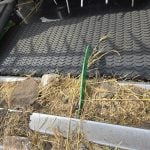Taking the good and bad
There was good and bad news in the United States Department of Agriculture’s world grain supply and demand report released last week.
The good news concerned wheat. Oilseeds got the bad news. The numbers are in the chart on page 15.
In wheat, the USDA sees world production shrinking by three percent in 1999-2000 and trade improving, thanks largely to improved prospects for several Asian economies.
The information led the USDA to forecast world stocks of wheat by the end of 1999-2000 will drop 14 percent to 117.65 million tonnes.
Read Also

China’s grain imports have slumped big-time
China purchased just over 20 million tonnes of wheat, corn, barley and sorghum last year, that is well below the 60 million tonnes purchased in 2021-22.
That is still shy of the 105 million tonnes in ending stocks in 1995-96 that helped wheat prices soar to record highs, but much better than the last two years when stocks were 135-140 million tonnes.
Many analysts believe traders will start to focus on the tightening world stocks once the U.S. harvest is in. Prices should start to rise through the rest of 1999-2000.
Short-term drop
In the meantime, look for wheat prices to drift lower this summer. Right now, USDA forecasts a 14 percent drop in winter wheat production, but that is based on average yields.
The winter crop is in good shape and has been helped by recent rains. Expect to see USDA boost yield projections as harvest nears.
If the U.S. again gets record-setting yields it could offset the price-positive aspects of the global stocks number. Also, it is important to note U.S. stocks are forecast to drop more modestly than global stocks and the American commodity markets that set world prices tend to focus a lot on the domestic supply-demand situation.
Turning to oilseeds, the forecast of record U.S. soybean production coupled with big stocks at the start of the 1999-2000 crop year mean year-end stocks will grow even if the forecasts of record domestic crush and exports are correct.
The news is affecting canola prices, a crop suffering from its own set of overproduction problems.
If the predicted increased Asian demand for imported oilseed fails to materialize, things could get worse.
Locking in a price now for 1999 production might seem like a losing proposition. But ask hog farmers if they wish they’d locked in a price last August for a slight loss instead of losing their shirts on the cash market in December.














